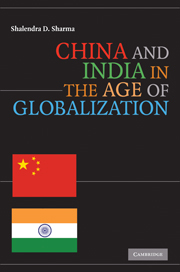Book contents
- Frontmatter
- Contents
- Acknowledgments
- Acronyms
- Political Map of China
- Political Map of India
- Introduction: China and India in the Age of Globalization
- 1 Prelude to Globalization: China (1949–1978) and India (1947–1991)
- 2 China and India Embrace Globalization
- 3 China: Strategies and Patterns of Global Integration
- 4 India: Strategies and Patterns of Global Integration
- 5 Sino-Indian Relations: Partners, Friends, or Rivals?
- 6 India and the United States: From Estrangement to Engagement
- 7 The Rise of China and Its Implications for the United States
- 8 China and India: Future Challenges and Opportunities
- Bibliography
- Index
8 - China and India: Future Challenges and Opportunities
Published online by Cambridge University Press: 22 January 2010
- Frontmatter
- Contents
- Acknowledgments
- Acronyms
- Political Map of China
- Political Map of India
- Introduction: China and India in the Age of Globalization
- 1 Prelude to Globalization: China (1949–1978) and India (1947–1991)
- 2 China and India Embrace Globalization
- 3 China: Strategies and Patterns of Global Integration
- 4 India: Strategies and Patterns of Global Integration
- 5 Sino-Indian Relations: Partners, Friends, or Rivals?
- 6 India and the United States: From Estrangement to Engagement
- 7 The Rise of China and Its Implications for the United States
- 8 China and India: Future Challenges and Opportunities
- Bibliography
- Index
Summary
In April 2008, the World Bank issued a public statement warning that skyrocketing food and fuel prices were threatening recent hard-won gains in overcoming poverty and malnutrition throughout the world. More ominously, it warned that the sharp increases in global prices (overall global food prices increased by 83 percent over the 36 months leading up to February 2008) are expected to remain high throughout 2008–9, and likely remain well above the 2004 levels through 2015, for most food crops. While China and India have not experienced the large-scale and often violent protest and riots over rising food prices that have hit several countries, including Bangladesh, Mexico, Zimbabwe, Egypt, Haiti, Indonesia, Cameroon, Peru, Somalia, Guinea, Mauritania, Morocco, Senegal, Uzbekistan, Yemen, and Argentina, there is palpable worry that the current rise in consumer inflation (which is close to 8 percent in India and slightly higher in China) has the potential to reverse dramatically the gains in poverty reduction in both countries. This is a particularly worrisome concern for India because one in every four Indians lives on less than $1 a day, and three in four earn $2 or less. This is because food price inflation is the most regressive of all taxes – it hurts the poor the most because food accounts for a relatively high proportion of their expenses.
- Type
- Chapter
- Information
- China and India in the Age of Globalization , pp. 248 - 276Publisher: Cambridge University PressPrint publication year: 2009

